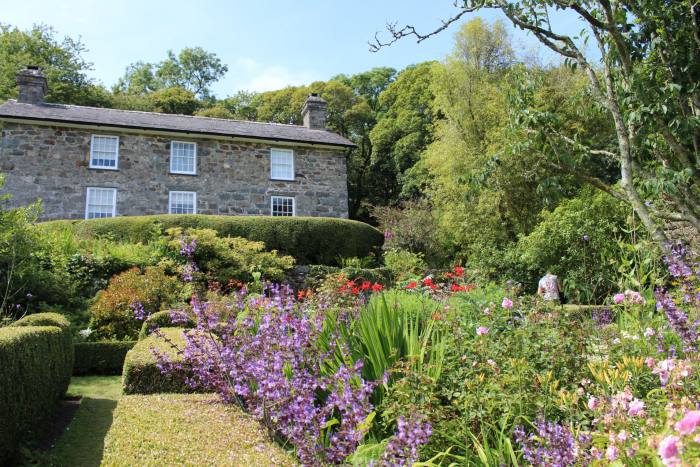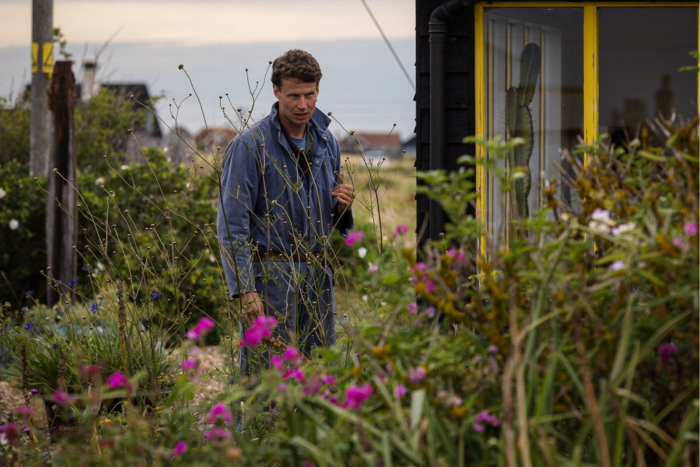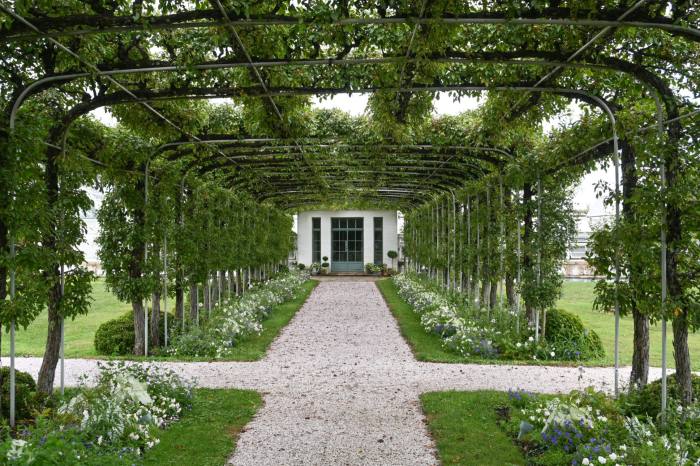How to inherit a garden: the complexities of horticultural legacy
Some gardens and landscapes are works of art that deserve to be left to posterity. But unlike an oil painting with an enigmatic smile or a stainless steel sculpture of a balloon dog, their changeable nature makes them delicate legacies.
Owners thrive on adapting their garden when an ornamental tree falls, an obelisk crumbles, a gnome escapes, a stream runs dry, or an important plant species succumbs to disease. But what should an heir do in the face of the same problems? Should heirs keep the design of the garden and the original planting? Should donors impose conditions? How should heirs deal with benefactor wishes?
Plas yn Rhiw, a pretty 1-acre garden overlooking Cardigan Bay in Wales, was given to the National Trust in the mid-20th century on condition, among other things, that the wild bees should not be disturbed and that the yew and box hedges should be preserved . The former condition is fine – even admirable – but the latter is difficult as boxwood falls prey to three types of rot, Phytophthora root rot and boxworm – not to mention various scale insects, the red spider mite. . . you have the idea
Perhaps it’s no surprise, then, that the Trust has become increasingly picky about what it does. But in recent decades, alternative solutions to inherited gardens are emerging.
Great Dixter in southern England is one such. Christopher “Christo” Lloyd’s garden has thrived and developed since his death in 2006
The garden style was rebellious and its infamous gesture against pastel floral colors in the 1990s set the tone for the ongoing rebellion at Great Dixter, now helmed by Fergus Garrett.

Plas yn Rhiw, Cardigan Bay, Wales, has been conditionally left to the National Trust © National Trust Images/Gwenno Parry
“I’ve used pastels about five or six times since Christo’s death in 2006, but every time I do it raises my eyebrows,” says Garrett. “I used mostly gray on gray in the solar garden this year and it looks great – but not to everyone’s taste. Next year will likely be shocking magenta and scarlet – but only if the wind takes us there – never because we gave in to public pressure.”
“It’s important not to copy too much, but to keep the sense of adventure, whimsy, happiness, strong work ethic, curiosity and pass it all on,” says Garrett, who learned his skills on Christo’s knee. “Christo set up the trust and we selected trustees together and made me director.”
Great Dixter is a small charity, says Garrett, that’s working hard to break even. With a turnover of over £1m, it supports 50 full-time and part-time staff including tour guides. “We could open for weddings and have a restaurant to make more money, but that would destroy Dixter,” he says. “We raise money through study days, plant fairs and so on and put it back into the garden, scholarships for students and employing local people.”
What is the successor plan like now? “There are four or five people who could take over – ex-students or gardeners,” he says.
Sir Roy Strong’s garden, The Laskett in Herefordshire, is a living archive of his life, his marriage to designer Julia Trevelyan Oman and, well, a rich cultural history. In 1999, the National Trust declined its offer to donate The Laskett because, in the words of one representative: “[The gardens did not meet] our strict criteria of significance, nor did we believe that the National Trust had to acquire the gardens to secure their future.”
In 2021, Perennial, formerly the Gardeners’ Benevolent Institution, accepted Strong’s generous gift from The Laskett and featured it in a video at the Chelsea Flower Show earlier this year.

Christopher Lloyd in his garden at Great Dixter, East Sussex; it has continued to grow since his death in 2006 © Jonathan Buckley

Sir Roy Strong at his former home, The Laskett, Herefordshire; his garden was rejected by the National Trust © CAMERA PRESS/Adrian Sherratt
“They asked me to be a trustee for The Laskett,” says Strong of the garden he and Trevelyan-Oman created from scratch in 1972. He declined: “I’ve sat on every damn committee in this country. That’s it!”
“There’s only one way to live: forward,” says Strong, who two years ago began planting his new garden a few miles from The Laskett, though he adds his ashes join those of his wife in his original garden becomes. Eventually, Perennial will inherit part of Strong’s estate, he says, adding that “the value of what I gave them was £3million, which is no insignificant amount”.
Money, “in millions rather than hundreds of thousands,” is one of five tests Perennial applies to each garden heritage offering. Peter Newman, managing director of the charity, explains the tests: “Is it a garden that matters? Is it idiosyncratic? Was it made with passion, skill and love? Is there a financial risk? Is it the right place for the charity to spread its message across the UK? Is the garden unrestricted?

The 17th-century gardens at Valsanzibio in Veneto, Italy have been run by the same family for three generations © Tenuta Valsanzibio srl
“Our main job is to mentor gardeners and gardeners,” he says of the charity’s core mission. “The gardens we accept convey our message, introduce potential supporters and must be run as profit centers, not cost centers.”
Endowments are crucial for institutions considering whether or not to accept a garden gift, although estimates of how much money is needed vary as widely as the gardens. “The Trust uses a regularly reviewed formula to calculate the amenities required for a property to ensure it has a sustainable future. Factors such as long-term cyclical maintenance tasks are taken into account,” a spokesman for the National Trust tells me.
Armando Pizzoni Ardemani hopes his family can preserve their 17th-century gardens in Valsanzibio in Veneto, Italy, as they have for three generations.
The 20-acre garden was described by Edith Wharton in 1903 as “one of the finest amusement parks in Italy.” The historical trees, water features, allegorical statues and labyrinth are reached through a magnificent water gate through which gondolas used to glide from Venice when the canals stretched 60 km to the great commercial city. Its hard and soft landscapes are as delightful to visit as they are troublesome to maintain.
Pizzoni has turned Valsanzibio into a going concern by opening it to the public and selling a plot of land to an American institution. He also hopes for two million euros in EU funding. On the other hand, he says: “I don’t want to force the children to do this.”
He says his sons, ages 12 and 17, love Valsanzibio, “but hers is childish
Love. This place can give you a lot of satisfaction, but it’s a lot of responsibility. You have to have passion like me,” says Pizzoni, who wants to create a circular economy that generates energy, plants and animals from the estate, which includes 200 hectares of forest.
Passion and money go into creating some of the world’s most remarkable gardens and helping some survive their creators: Derek Jarman’s wild coastal garden, in the lee of Dungeness power station on the UK’s south coast, is turning £3.5million into a Art Fund campaign nurturing gardener Jonny Bruce and others for the future.

Gardener Jonny Bruce in Derek Jarman’s garden in Dungeness supported by £3.5million from an Art Funds campaign © Andrew Ogilvy
The new owners of Peter Smithers’ forest garden in Switzerland above Lake Lugano have the passion and understanding to continue the garden according to Smither’s plan, although it is never officially open to the public. Little Sparta, the beautiful complex 7-acre landscape created by artist Ian Hamilton Finlay and his wife Sue in the Pentland Hills near Edinburgh, is held together by a trust established before Hamilton Finlay’s death in 2006 became.
Other historically important private gardens, such as Rousham in Oxfordshire, have survived thanks to dedicated families who have owned the gardens for centuries.
In the US, the Oak Spring Garden in Virginia only opens occasionally, but shows how important gardens can be successfully passed on to future generations.
Owner Bunny Mellon, who created two White House gardens, took over half a century to create her own. Glitterati including Jackie Kennedy were regular visitors. At her death in 2014, philanthropist Mellon left funds but no conditions for the garden or her estate. Her main concern was her renowned library of manuscripts, books and artworks in the fields of horticulture, landscape design, botany and natural history.

Oak Spring Garden, Virginia was endowed with funds from its creator, philanthropist Bunny Mellon © Oak Spring Garden Foundation
Sir Peter Crane (a former director of Kew) was appointed President of Oak Spring in 2016, with the task of transforming it from an idiosyncratic private domain into a place visited by scholars and artists from around the world. He repurchased land to restore the core of the once 4,000-acre estate and set about restoring the gardens, taking Mellon’s comment into account: “Gardens, like many beautiful things you think will never change . . . never die – they follow the cycle of all living beings – never stay the same. . . ”
The ever-changing gardens have never looked better, and apart from Mellon’s helpful commentary on the cycle of living things, she seems to have found an excellent formula for garden legacies: involve the right people, throw in a sizable endowment, and make no strings attached.
Jane Owen is an editor at FT and Gold Medalist at the Chelsea Flower Show
Be the first to find out about our latest stories – follow @FTProperty on Twitter or @ft_houseandhome on Instagram